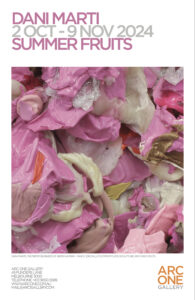Exhibitions
Vermell Furiós
Dominik Mersh GallerySydney2025
Summer Fruits
ARC ONE GalleryMelbourne2024
Wall Hangings
GAG ProjectsAdelaide2024
Oh Canola!
MRAGMaitland - Australia2022
THE ART OF PROTEST
Newcastle Art GalleryNewcastle , Australia2021
The Graceful Exit- group exhibition
Dominick Mersh GallerySydney2021
Dust
Gallerie HilgernextVienna2021
Songs of Surrender
Gallerie LausbergDusseldorf2021
Blue on Blue
Arc One GalleryMelbourne, Australia2020
52 actions 52 artists – Artspace, Sydney and VOMA , London, UK
Artspace and VOMASydney and London2021
Between
Dominik Mersch GallerySydney2020
Friendship a way of Life
University of New South Wales GalleriesSydney2020
Blow
Turner GalleriesPerth, Australia2018
Red on Red
Dominik Mersch Gallery - DMGSydney2018
Slow
GAG-Greenaway Art GalleryAdelaide2015
I Am
Arc One GalleryMelbourne2017
Still life in Yellow, Steel and Mandarins
The University Art GalleryNewcastle University, Australia2016
Fool’s Paradise
Dominik Mersch GallerySydney, Australia2016
Black Sun
Fremantle Art GalleryPerth2016
Adelaide Biennial- Dark Heart
Art Gallery of South AustraliaAdelaide2014
Run, Run, Run
Arc One GalleryMelbourne2014
Surface Tension
Westfield Head OfficeSydney2014
Mariposa
BreespaceSydney2012
And That’s It
GAG-GreenawayAdelaide2011
Found
Glen Eira City Council Art GalleryVictoria2011
The Book of Miracles
Arc One GalleryMelbourne2011
Tarcoola
PelotonSydney2012
Touch: the portraiture of Dani Marti
Newcastle Art GalleryNewcastle2011
The Ethics of Encounter
Stills GalleryEdinburgh2011
Bacon’s Dog
BreespaceSydney2010
Insideout
GoMA-offsiteGlasgow2009
Glasgow International – Transit
Glasgow International Project SpaceGlasgowNovember 2008
Off my noodle
Newcastle Art Gallery / UTS GalleryNewcastle/Sydney2007
One Breath Below Consciousness
BreenspaceSydney2008
Time is the Fire in which We Burn
Arc One GalleryMelbourne2009
Australian
Casula Power HouseLiverpool , AustraliaFebruary 2008
Closer
Arc One GalleryMelbourne2007
Dark Bones
Citric GalleryBrescia, Italy2006
Glittering Shadows
Glasgay GalleryGlasgow2007
Goods to Declare
Ben-Gurion AirportIsrael2006
The Seven Pleasures of Snow White
Sherman GalleriesSydney2006
There is Nothing at the End of the Rainbow
Arg One GalleryMelbourne2005
Orifices
Newcastle Art Gallery, AustraliaNewcastle , Australia2005
Variations in a Serious Black Dress
Various Regional Art GalleriesAustralia2004-2006
Marks and Comments: GSA
TranwayGlasgow2006
Looking for Rover
Sherman GalleriesSydney2004
Variations in a Serious Black Dress
Gitte Weise GallerySydney2003
Jamon
La CapellaBarcelona2003
Portrait of a young man returning a ladybird
Arc One GalleryMelbourne2003
Ruin
Helen Lempriere National Sculpture AwardWerrebee Park , Melbourne2002
I am forever blowing bubbles
Gitte Weise GallerySydney2001
You make me feel like love, peace and happiness
Gallery 4ASydney2001
Plastic by Nature
Canberra Contemporary Art SpaceCanberra2001
Missing Spain
Casula Power HouseLiverpool, Australia2001
Thin Wall
ArtSpaceSydney, Australia2000
Looking for Felix
first draft GallerySydney2000
ws-s
Gitte Weise GallerySydney1999
‘Sorry I just dropped my guts ‘
Casula PowerhouseSydney2000
 Fruit is an ancient metaphor for human flesh; plastic, a new one.
Fruit is an ancient metaphor for human flesh; plastic, a new one.